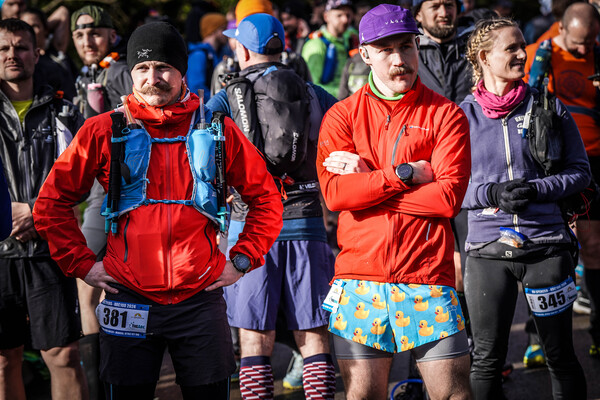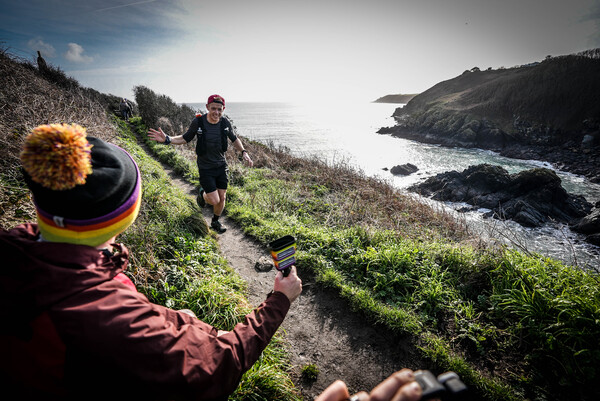With the longest runs and hardest workouts in the books, I’m ready to collapse into the taper’s welcoming arms just in time to recover for race day. But the work is still far from over at this point. As the physical aspect of training winds down, the mental component ramps up in its place.
For Energizer Bunny athletes (like yours truly) who have more psych than sense sometimes, peak weeks are the easy part - at least in comparison to the taper. Big miles feel tangibly productive in a way that kicking back and recouping energy doesn’t. But filling the hours you would be spending on foot with other forms of race preparation goes a long way toward warding off taper tantrums. That can include anything from meticulously organizing your drop-bags to laying out your race day kit in six different orientations, to something that most people breeze over: honing your mental plan of attack.
It’s easy to ignore this side of performance. Meditation sessions don’t earn Strava kudos, and visualization doesn’t deliver the instant gratification of sore muscles. Spare time also doesn’t grow on trees any more than money does, so those of us trying to exist as a functional adult and an athlete have to make choices.
That’s why taper weeks present the perfect opportunity to shift your focus. With far fewer miles on the schedule, there’s no excuse for avoiding mental preparation. The more you can practice building your cognitive skills ahead of time, the better you’ll handle the inevitable rollercoaster ride of emotions and energy on the course.
These are the five areas I’m focusing on as a mental performance consultant and ultrarunner while tapering into the Black Canyon 100k. I'm relying on them to sharpen concentration, ease intimidation, and - maybe most importantly - keep me sane in the absence of my typical training load.
1. Goal-Setting
I’m a huge proponent of setting goals throughout the entire training block, down to specific intentions for every single session, but race day goals deserve their own dedicated effort. Research suggests that setting clear goals before an event improves performance by reducing anxiety and increasing self-confidence, self-efficacy, motivation, commitment, concentration, and overall effort compared to going in without a clue. That’s evidence enough to steer clear of the “wing it” method.

That same research makes a distinction between two types of race day goals: performance-based vs. process-based goals.
- Performance-based goals focus on outcomes, like times and rankings.
- Process-based goals focus on behaviors instead, like nailing your nutrition plan or maintaining a particular rate of perceived effort.
Process-based goals trigger more of an improvement in performance than the alternative because they highlight what you as an athlete can actually do, rather than what you hope to happen. Action begets outcome. The more you focus on what you can control, the more likely you are to achieve the outcome you’re looking for without hyperfixating on it so much that the pressure saps your potential.
I know what I want to happen on race day. But I also know that putting too much emphasis on this will have the opposite effect. So I take what I want to happen and I work backwards by asking myself:
What do I need to do in order to give myself a fighting chance in this race?
For me, that includes…
- Fueling like a carb-loaded champ throughout the entire taper and hitting all nutrition windows on race day
- Smiling as wide as I can muster at everyone and everything I pass on the trail
- Breaking down the distance to ground myself in the present moment
- Narrowing my field of vision to stay focused on my immediate surroundings
- Maintaining a quick cadence to keep from eating sh*t on technical slickrock
- Continuously monitoring my RPE (Rating of Perceived Exertion) so I don’t burn out too fast or go too easy on myself
Among others, these are some of the actions that bring out the best version of myself. Nothing’s guaranteed and whatever happens, happens. But sending my mental energy toward these behaviors puts me in the most control of how I run on race day.

2. Humanizing
Imposter syndrome hits hard during taper weeks. No one, no matter how accomplished or experienced, is immune to feeling like a fraud compared to everyone else on the start line. I’m a pretty fresh addition to the elite racing field, so you can bet that part of me truly believes I’m in for the ass-kicking of a lifetime at such a highly competitive race.
Maybe I am, maybe I’m not. That’s beside the point. Imposter syndrome comes from putting your peers on a pedestal. But they’re ultimately no less human than you or anyone else. I make a conscious effort to humanize the incredible women I’ll be racing with in my mind before we meet in person on the course. I’ll start conversations with them, share my excitement to meet them, try to decipher their “why” for running, and spend some time exploring what they’re all about as people—not only as athletes.
I do this to remind myself that they got to where they are via the same tumultuous path that I’m taking too. They don’t have some magic formula to success that I don’t. We’re all there because we love what running brings to our lives and we work hard to make the most of that love. That’s the kind of energy I can feed off of. Humanizing the other runners allows me to see them as motivators rather than competitors.
3. Self-Talk
During the pre-race meeting for the Leadville 100 in 2023, the race director said something to all the assembled crew chiefs that I’ll always remember: “Your runner will get stupid out there.” Nothing more true could be said of the human brain during an ultramarathon.
Running for hours and hours (and hours) will turn grown adults back into toddlers. Research on how fatigue impairs emotional intelligence and regulation says as much. The cognitive load involved in tackling long distances at high intensities puts an enormous strain on the brain. Thinking clearly becomes more and more difficult as the miles add up.
With that in mind, you can’t trust your brain to think productive thoughts on its own accord while you’re racing. That’s too much to ask of an overwhelmed organ that’s convinced you're dying, because why else would you be running so hard for so long? Since fear can breed negativity, it’s not worth leaving your train of thought up to chance. Instead, planning ahead for “dumb run brain” makes it possible to control your inner monologue better.
In the weeks leading up to a race, I pick the specific self-talk mantras that I’ll use to tame my train of thought while running. My options include a mix of motivational and instructional phrases that boil my thoughts and actions down to their most basic elements. They tell me exactly how to feel and what to do based on the attitude I want to have during the race.
Deciding on my mantras ahead of time allows me to practice them until they’re second nature. Then, even when my brain starts to get stupid, they’re ready and waiting at the forefront.
4. Simulation
Race day comes with more surprises than not. It’s impossible to predict everything that could happen once the gun goes off. Simulation serves to help you mentally prepare for some of the possible scenarios, while giving you the confidence to believe that if you know how to handle x, then surely you can figure out how to deal with y too.

I start by brainstorming all of the “worst case scenarios” that cross my mind: what could happen if everything goes wrong? This is not only helpful from a planning standpoint, but also emotionally cathartic. Putting my fears into words diminishes their power.
Then I do the same for all the “best case scenarios” I can think of: what could happen if everything goes right?
From there, I find ways to simulate each of those scenarios. Some of them I can physically replicate, like wearing my race kit, navigating the course, and practicing various fueling options.
Others make more sense to simulate via visualization, like puking my guts out for three hours straight or rolling an ankle five miles out from the nearest aid station. In those cases, I’ll create a mental image of the circumstances in as much vivid detail as possible, going through a checklist of my five senses:
What would I see/smell/hear/taste/feel in this situation?
And even more importantly: How would I react and respond to this situation in a way that I can be proud of?
If any of those situations I’ve rehearsed - in reality or in my mind - actually end up happening, they won’t throw me off because I already know what to expect. Even situations that I don’t predict and rehearse won’t carry as much weight, because I’ll know that I’ve trained my mind to think pragmatically in the face of surprise.
5. Segmenting
Ultramarathons are mindbogglingly long. I mean that in the sense that the brain struggles to comprehend going the entire distance. The dread that ensues when you do try to mentally digest it can be enough to keep a runner from continuing on. DNF’s happen when runners start ruminating on how far left they have to go.
Making it through to the finish requires a little self-deception. I figure out during training what my brain needs to hear in order to think that I’m not really running that far. That means breaking down the distance into manageable chunks based on things like landmarks, aid stations, fueling windows, and pacer swaps. I map out the course around these points to practice seeing the race as a series of small races, each with their own specific focal points.

Not only that, but I practice breaking everything into segments, from work projects to household chores to conversations with friends. This gets my mind in the habit of seeing the whole as a mere sum of its parts. If I can stay so present that I don’t wonder when I’ll be done, I’ll convince my brain that it’s up to the task…by lying to myself about what the task actually entails.
Sometimes knowledge is power. Other times, like at mile 45 with 17 more and two steep climbs left to go, ignorance works a hell of a lot better.
